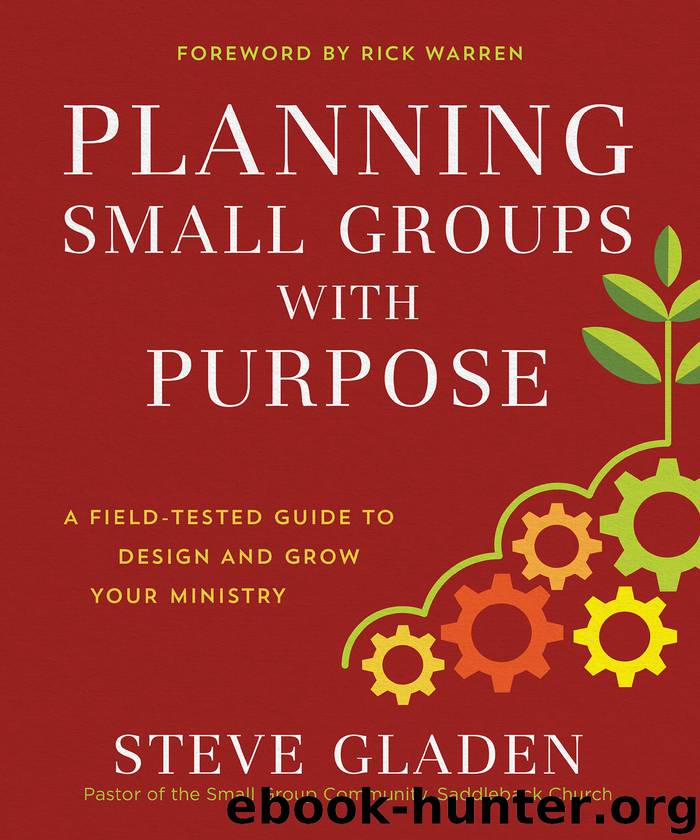Planning Small Groups with Purpose by Steve Gladen

Author:Steve Gladen
Language: eng
Format: epub
Tags: Church Life / Small Groups;Church group work—Planning;Small groups—Planning;REL074000;REL108010;REL109000
ISBN: 9781493414147
Publisher: Baker Publishing Group
Published: 2018-04-30T16:00:00+00:00
The cons of a connection strategy to start groups are:
May kill evangelism by replacing church attendees’ existing friends with new churched friends
Some less-than-ideal group fits because the strategy uses a degree of randomness
More real-time customer service for people who might be at a table that isn’t going well
For instructions for a connection event, see www.SmallGroups.net/connection.
Campaign Strategy
Saddleback Church was the first church to successfully use the campaign strategy. A campaign is forty days of intensive, churchwide focus on a particular aspect of spiritual growth for each age group. It encompasses weekend sermons, small group curriculum, children’s activities, student ministry programs, social media, and more. One goal of our campaigns is to start new small groups.
Campaigns grew out of Rick’s challenge to pray and work toward exponential group growth (see the “Exponential Thinking” section on pages 114–15). We needed a new strategy to accomplish the numbers he had in mind. This was also when we came up with the Host role, which is the only way we’ve found to initiate large numbers of new groups out of a campaign. As part of the campaign we ask the congregation, “If our church has ministered to you, would you in turn minister to your community and be willing to Host a small group for six weeks? All you need is two friends to start a group!” (See pages 137–39 for more on starting groups with two friends.) The first time we did this, response was overwhelming, and suddenly we had plenty of people willing to initiate new groups and lead them for the short term.
Some of these groups don’t continue beyond their initial six-week commitment. But that’s not reason for discouragement. Healthy groups will stay in place, growing the ministry beyond where it was. After one of our campaigns, we looked in depth at the reasons groups discontinued and found it was not because they didn’t have a good experience. It was because life got in the way, and our leader coaching infrastructure wasn’t in place to support Hosts. We reevaluated our infrastructure, and two years later, after our next campaign, our retention rate went from 68 percent to 86 percent.
We learned by stepping out in faith and attempting the seemingly impossible. We moved ahead before we had all the details ironed out, and we made some mistakes. But we learned from them and moved forward. Saddleback’s campaign resources are available at https://store.pastors.com/campaign-central so you can avoid some of our mistakes.
I’m now a multidecade veteran of campaigns at Saddleback, and I’ve discovered that a strategy is only as good as the foundation and follow-through. To ensure a positive outcome, check out my battle-tested tips:
Choose a compelling question, such as “What on earth am I here for?” (from our 40 Days of Purpose campaign), to motivate people to join small groups.
Align children, student, and adult ministries. This encourages natural discussions at home among all family members. It also emphasizes the importance of every church member, not just adults.
Stick to the principles, and apply your own methodologies.
Download
This site does not store any files on its server. We only index and link to content provided by other sites. Please contact the content providers to delete copyright contents if any and email us, we'll remove relevant links or contents immediately.
Joan of Arc by Mary Gordon(3792)
Victory over the Darkness by Neil T. Anderson(2733)
The Gnostic Gospels by Pagels Elaine(2400)
Devil, The by Almond Philip C(2207)
The Nativity by Geza Vermes(2117)
The Psychedelic Gospels: The Secret History of Hallucinogens in Christianity by Jerry B. Brown(2075)
Going Clear: Scientology, Hollywood, and the Prison of Belief by Lawrence Wright(1884)
Going Clear by Lawrence Wright(1873)
A TIME TO KEEP SILENCE by Patrick Leigh Fermor(1775)
Barking to the Choir by Gregory Boyle(1732)
Old Testament History by John H. Sailhamer(1715)
Augustine: Conversions to Confessions by Robin Lane Fox(1688)
A History of the Franks by Gregory of Tours(1640)
The Bible Doesn't Say That by Dr. Joel M. Hoffman(1611)
A Prophet with Honor by William C. Martin(1603)
The Knights Templar by Sean Martin(1598)
by Christianity & Islam(1564)
The Amish by Steven M. Nolt(1492)
The Source by James A. Michener(1460)
